Frigidaire 134940700A User Manual
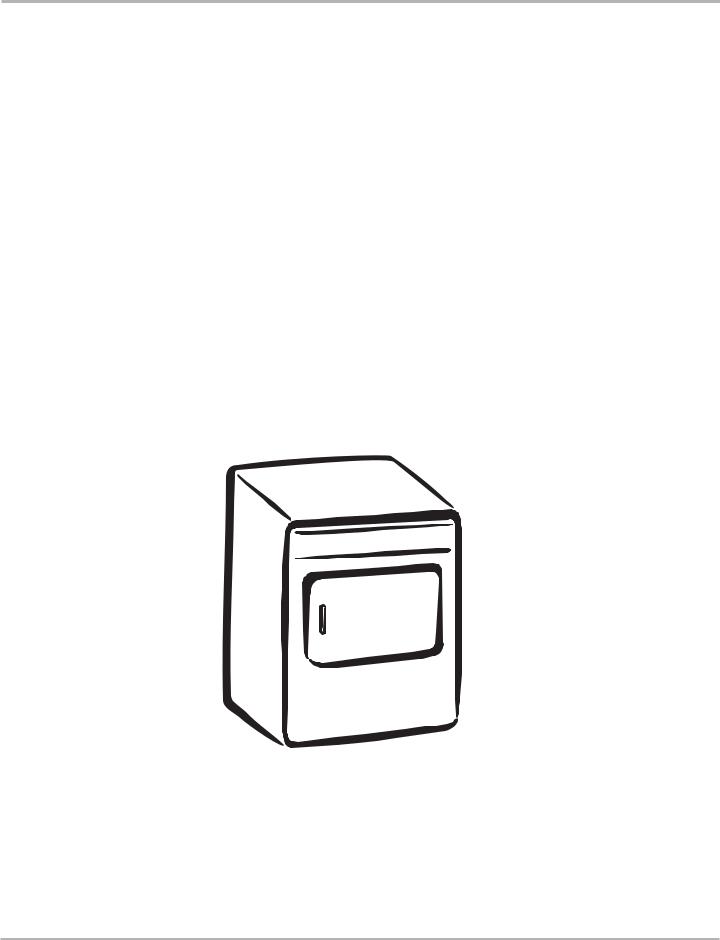
Installation
Instructions
Gas & Electric Dryer
Instrucciones para la
instalación
Secadora a Gas y Eléctrica
www.frigidaire.com |
1 |
P/N 134940700A (0804) |
|
|
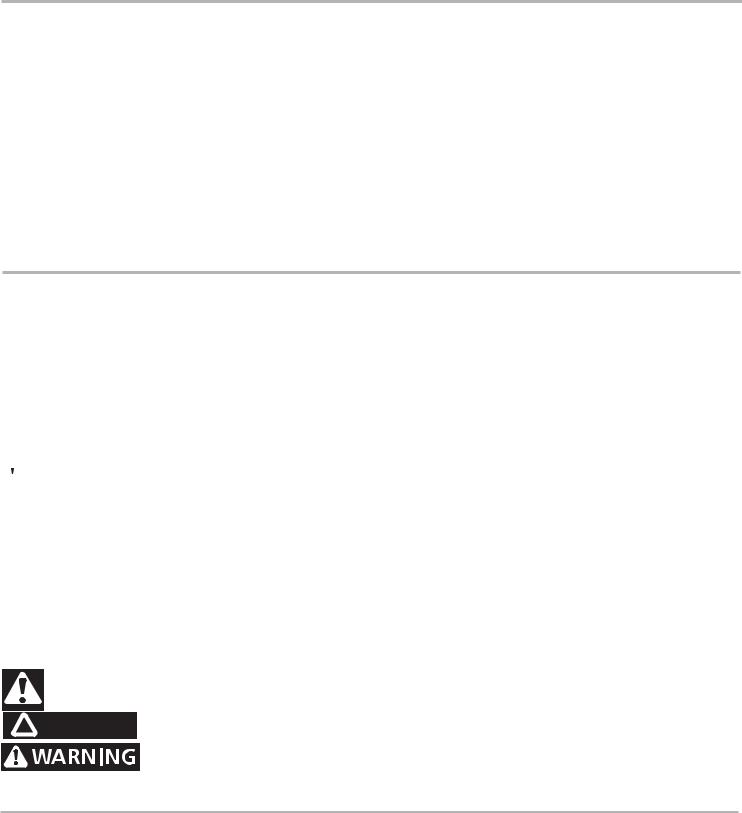
|
CONTENTS |
Pre-Installation Requirements.......................................................................................................................................... |
2 |
Electrical Requirements.................................................................................................................................................. |
3 |
Exhaust System Requirements...................................................................................................................................... |
3-4 |
Gas Supply Requirements............................................................................................................................................ |
4-5 |
Location of Your Dryer.................................................................................................................................................... |
5 |
Rough-In Dimensions..................................................................................................................................................... |
6 |
Mobile Home Installation............................................................................................................................................... |
7 |
Unpacking ................................................................................................................................................................... |
7 |
Reversing Door Swing................................................................................................................................................. |
8-9 |
Electrical Installation.................................................................................................................................................... |
10 |
Grounding Requirements.............................................................................................................................................. |
10 |
Electrical Connections—3-wire....................................................................................................................................... |
11 |
Electrical Connections—4-wire........................................................................................................................................ |
11 |
Gas Connection............................................................................................................................................................ |
12 |
General Installation....................................................................................................................................................... |
12 |
Replacement Parts........................................................................................................................................................ |
12 |
Español.................................................................................................................................. |
13-24 |
SAFETY INSTRUCTIONS
Clothes dryer installation and service must be performed by a qualified installer, service agency or the gas supplier. Install the clothes dryer according to the manufacturer's instructions and local codes.
Before beginning installation, carefully read these instructions. This will simplify the installation and ensure the dryer is installed correctly and safely. Leave these instructions near the Dryer after installation for future reference.
NOTE: The electrical service to the Dryer must conform with local codes and ordinances and the latest edition of the National Electrical Code, ANSI/NFPA 70, or in Canada, the Canadian electrical code C22.1 part 1.
NOTE: The gas service to the Dryer must conform with local codes and ordinances and the latest edition of the National Fuel Gas Code ANSI Z223.1, or in Canada, CAN/ACG B149.1-2000
NOTE: The Dryer is designed under ANSI Z 21.5.1 or ANSI/UL 2158 - CAN/CSA C22.2 No. 112 (latest editions) for HOME USE only. This Dryer is not recommended for commercial applications such as restaurants or beauty salons, etc.



 RISK OF FIRE. For your safety the information in this manual must be followed to minimize the risk of fire or explosion or to prevent property damage, personal injury or loss of life. SAVE THESE INSTRUCTIONS.
RISK OF FIRE. For your safety the information in this manual must be followed to minimize the risk of fire or explosion or to prevent property damage, personal injury or loss of life. SAVE THESE INSTRUCTIONS.
-Do not store or use gasoline or other flammable vapors and liquid in the vicinity of this or any other appliance.
-WHAT TO DO IF YOU SMELL GAS
·Do not try to light any appliance.
·Do not touch any electrical switch; do not use any phone in your building.
·Clear the room, building or area of all occupants.
·Immediately call your gas supplier from a neighbor’s phone. Follow the gas supplier's instructions.
·If you cannot reach your gas supplier, call the fire department.
Installation and service must be performed by a qualified installer, service agency or the gas supplier.
Your safety and the safety of others is very important.
We have provided many important safety messages in the Use & Care Guide, Operating Instructions, Installation Instructions and on your appliance. Always read and obey all safety messages.
This is the safety alert symbol. This symbol alerts you to hazards that can kill or hurt you or others. All safety messages will be preceded by the safety alert symbol and the word "DANGER" or "WARNING". These words mean:
 DANGER You will be killed or seriously injured if you don't follow instructions.
DANGER You will be killed or seriously injured if you don't follow instructions.
You can be killed or seriously injured if you don't follow instructions.
All safety messages will identify the hazard, tell you how to reduce the chance of injury, and tell you what can happen if the instructions are not followed.
PRE-INSTALLATION REQUIREMENTS
Tools and Materials Required for Installation:
1.Phillips head screwdriver.
2.Channel-lock adjustable pliers.
3.Carpenter's level.
4.Flat or straight blade screwdriver.
5.Duct tape.
6.Rigid or flexible metal 4 inch (10.2 cm) duct.
7.Vent hood.
8.Pipe thread sealer (Gas).
9. Plastic knife. |
2 |
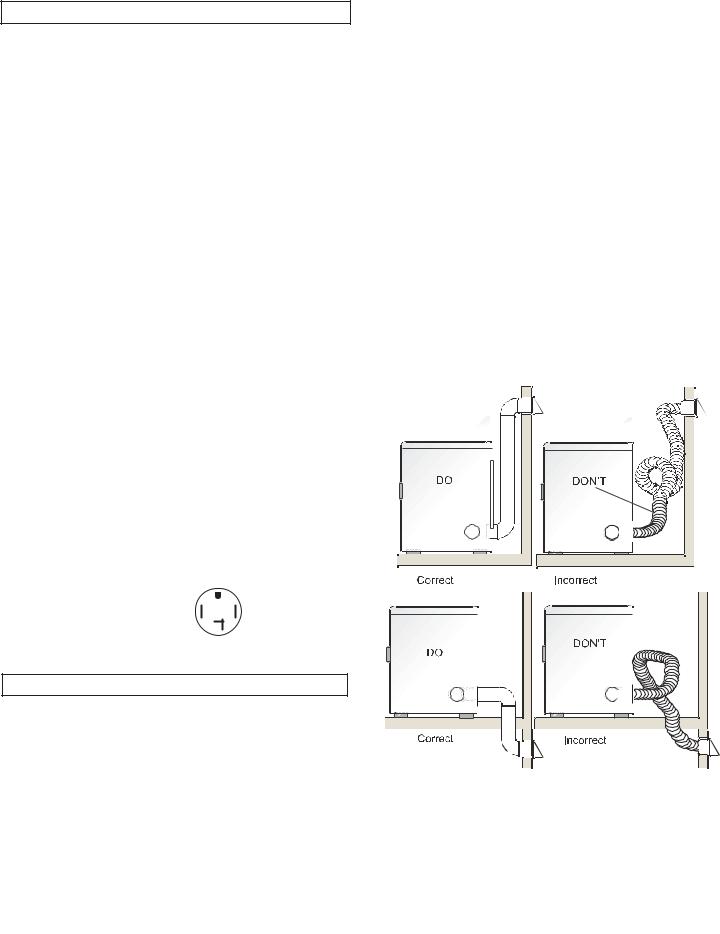
ELECTRICAL REQUIREMENTS |
EXHAUST SYSTEM REQUIREMENTS |
ELECTRIC Dryer
CIRCUIT - Individual 30 amp. branch circuit fused with 30 amp. time delay fuses or circuit breakers.
Use separately fused circuits for washers and dryers, and DO NOT operate a washer and a dryer on the same circuit.
POWER SUPPLY - 3 wire or 4-wire, 240 volt, single phase, 60 Hz, Alternating Current.
POWER SUPPLY CORD KIT - 3 wire - the dryer MUST employ a 3-conductor power supply cord NEMA 10-30 type SRDT rated at 240 volt AC minimum, 30 amp., with 3 open end spade lug connectors with upturned ends or closed loop connectors and marked for use with clothes dryers. See ELECTRICAL CONNECTIONS FOR A 3-WIRE SYSTEM.
4 wire - The dryer MUST employ a 4-conductor power supply cord NEMA 14-30 type SRDT or ST (as required) rated at 240 volt AC minimum, 30 amp., with 4 open end spade lug connectors with upturned ends or closed loop connectors and marked for use with clothes dryers. See ELECTRICAL CONNECTIONS FOR A 4-WIRE SYSTEM.
(Canada - 4-wire power supply cord is installed on dryer.)
WARNING – Risk of Shock. Appliance grounded to neutral conductor through a link. Grounding through the neutral link is prohibited for (1) New branch circuit installations (2) mobile homes; (3) recreational vehicles; and (4) areas where local codes do not permit grounding through the neutral, (1) disconnect the link from the neutral, (2) use grounding terminal or lead to ground appliance in accordance with local codes and (3) connect neutral terminal or lead to branch circuit neutral in usual manner (if the appliance is to be connected by means of a cord kit, use 4-conductor cord for this purpose). USE COPPER CONDUCTOR ONLY.
OUTLET RECEPTACLE - NEMA 10-30R receptacle to be located so the power supply cord is accessible when the dryer is in the installed position. (Canada - NEMA 14-30R receptacle.)
NEMA 10-30R NEMA 14-30R
GAS Dryer
CIRCUIT - Individual 15 amp. branch circuit fused with a 15 amp. maximum time delay fuse or circuit breaker.
POWER SUPPLY - 3 wire, 120 volt single phase, 60 Hz, Alternating Current.
POWER SUPPLY CORD - The dryer is equipped with a 120 volt 3-wire power cord.
NOTE: Do not under any circumstances remove grounding prong from plug.
GROUNDING PRONG
Use only 4 inch (10.2 cm) diameter (minimum) rigid or flexible metal duct and approved vent hood which has a swing-out damper(s) that open when the dryer is in operation. When the dryer stops, the dampers automatically close to prevent drafts and the entrance of insects and rodents. To avoid restricting the outlet, maintain a minimum of 12 inches (30.5 cm) clearance between the vent hood and the ground or any other obstruction.



 The following are specific requirements for proper and safe operation of your dryer. Failure to follow these instructions can create excessive drying times and fire hazards.
The following are specific requirements for proper and safe operation of your dryer. Failure to follow these instructions can create excessive drying times and fire hazards.



 Do not install a clothes dryer with flexible plastic venting materials. If your present system is made up of plastic duct or metal foil duct, replace it with a rigid or semirigid metal duct. In Canada and the United States if metal (foil type) duct is installed, it must be of a specific type identified by the appliance manufacturer as suitable for use with clothes dryers and in the United States must also comply with the Outline for Clothes Dryer Transition Duct, UL standard 2158A. Flexible venting materials are known to collapse, be easily crushed and trap lint. These conditions will obstruct clothes dryer airflow and increase the risk of fire. Ensure the present duct is free of any lint prior to installing dryer duct.
Do not install a clothes dryer with flexible plastic venting materials. If your present system is made up of plastic duct or metal foil duct, replace it with a rigid or semirigid metal duct. In Canada and the United States if metal (foil type) duct is installed, it must be of a specific type identified by the appliance manufacturer as suitable for use with clothes dryers and in the United States must also comply with the Outline for Clothes Dryer Transition Duct, UL standard 2158A. Flexible venting materials are known to collapse, be easily crushed and trap lint. These conditions will obstruct clothes dryer airflow and increase the risk of fire. Ensure the present duct is free of any lint prior to installing dryer duct.



 - Risk of Fire - A clothes dryer must be exhausted outdoors. Do not exhaust dryer into a chimney, a wall, a ceiling, an attic, a crawl space or any concealed space of a building. A clothes dryer produces combustible lint. If the dryer is not exhausted outdoors, some fine lint will be expelled into the laundry area. An accumulation of lint in any area of the home can create a health and fire hazard. The dryer must be connected to an exhaust outdoors. Regularly inspect the outdoor exhaust opening and remove any accumulation of lint around the outdoor exhaust opening and in the surrounding
- Risk of Fire - A clothes dryer must be exhausted outdoors. Do not exhaust dryer into a chimney, a wall, a ceiling, an attic, a crawl space or any concealed space of a building. A clothes dryer produces combustible lint. If the dryer is not exhausted outdoors, some fine lint will be expelled into the laundry area. An accumulation of lint in any area of the home can create a health and fire hazard. The dryer must be connected to an exhaust outdoors. Regularly inspect the outdoor exhaust opening and remove any accumulation of lint around the outdoor exhaust opening and in the surrounding
3 area.




 Do not allow combustible materials (for example: clothing, draperies/curtains, paper) to come in contact with exhaust system. The dryer MUST NOT be exhausted into a chimney, a wall, a ceiling, or any concealed space of a building which can accumulate lint, resulting in a fire hazard.
Do not allow combustible materials (for example: clothing, draperies/curtains, paper) to come in contact with exhaust system. The dryer MUST NOT be exhausted into a chimney, a wall, a ceiling, or any concealed space of a building which can accumulate lint, resulting in a fire hazard.



 Exceeding the length of duct pipe or number of elbows allowed in the "MAXIMUM LENGTH" charts can cause an accumulation of lint in the exhaust system. Plugging the system could create a fire hazard, as well as increase drying times.
Exceeding the length of duct pipe or number of elbows allowed in the "MAXIMUM LENGTH" charts can cause an accumulation of lint in the exhaust system. Plugging the system could create a fire hazard, as well as increase drying times.



 Do not screen the exhaust ends of the vent system, nor use any screws, rivets or other fastening means that extend into the duct and catch lint to assemble the exhaust system. Lint can become caught in the screen, on the screws or rivets, clogging the duct work and creating a fire hazard as well as increasing drying times. Use an approved vent hood to terminate the duct outdoors, and seal all joints with duct tape. All male duct pipe fittings MUST be installed downstream with the flow of air.
Do not screen the exhaust ends of the vent system, nor use any screws, rivets or other fastening means that extend into the duct and catch lint to assemble the exhaust system. Lint can become caught in the screen, on the screws or rivets, clogging the duct work and creating a fire hazard as well as increasing drying times. Use an approved vent hood to terminate the duct outdoors, and seal all joints with duct tape. All male duct pipe fittings MUST be installed downstream with the flow of air.



 Explosion hazard. Do not install the dryer where gasoline or other flammables are kept or stored. If the dryer is installed in a garage, it must be a minimum of 18 inches (45.7 cm) above the floor. Failure to do so can result in death, explosion, fire or burns.
Explosion hazard. Do not install the dryer where gasoline or other flammables are kept or stored. If the dryer is installed in a garage, it must be a minimum of 18 inches (45.7 cm) above the floor. Failure to do so can result in death, explosion, fire or burns.
|
|
|
MAXIMUM LENGTH |
|
|||
|
of 4” (10.2 cm) Dia. Rigid Metal Duct |
|
|||||
|
|
|
|
|
|
|
|
|
|
|
VENT HOOD TYPE |
|
|||
Number |
|
(Preferred) |
|
|
|
||
of |
|
|
|
|
Louvered |
|
|
90° |
|
|
|
|
|
|
|
Turns |
|
|
|
|
|
|
|
|
|
4” |
|
|
2½" |
||
|
(10.2 |
|
cm) |
|
|
(6.35 cm) |
|
|
|
|
|
||||
0 |
60 |
ft.(18.28 m) |
|
48 ft.(14.63 m) |
|||
1 |
52 |
ft.(15.84 m) |
|
40 ft.(12.19 m) |
|||
2 |
44 |
ft.(13.41 m) |
|
32 ft. |
(9.75 m) |
||
3 |
32 |
ft.(9.75 m) |
|
24 ft. |
(7.31 m) |
||
4 |
28 |
ft.(8.53 m) |
|
16 ft. |
(4.87 m) |
||
|
|
|
|
|
|
|
|
|
|
|
MAXIMUM LENGTH |
|
|||
Number |
of 4” (10.2 cm) Dia. Flexible Metal Duct |
||||||
|
|
VENT HOOD TYPE |
|
||||
of |
|
|
|
||||
|
(Preferred) |
|
|
|
|||
90° |
|
|
|
|
|||
|
|
|
|
Louvered |
|
||
Turns |
|
|
|
|
|
||
|
|
|
|
|
|
|
|
|
4” |
|
2½" |
|
(10.2 cm) |
|
(6.35 cm) |
0 |
30 ft. |
(9.14 m) |
18 ft. (5.49 m) |
1 |
22 ft. |
(6.71 |
m) |
14 ft. (4.27 m) |
2 |
14 ft. |
(4.27 |
m) |
10 ft. (3.05 m) |
3 |
|
|
NOT RECOMMENDED |
|
CORRECT INCORRECT
INSTALL MALE FITTINGS IN CORRECT DIRECTION
In installations where the exhaust system is not described in the charts, the following method must be used to determine if the exhaust system is acceptable:
1.Connect an inclined or digital manometer between the dryer and the point the exhaust connects to the dryer.
2.Set the dryer timer and temperature to air fluff (cool down) and start the dryer.
3.Read the measurement on the manometer.
4.The system back pressure MUST NOT be higher than 0.75 inches of water column. If the system back pressure is less than 0.75 inches of water column, the system is acceptable. If the manometer reading is higher than 0.75 inches of water column, the system is too restrictive and the installation is unacceptable.
Although vertical orientation of the exhaust system is acceptable, certain extenuating circumstances could affect the performance of the dryer:
•Only the rigid metal duct work should be used.
•Venting vertical through a roof may expose the exhaust system to down drafts causing an increase in vent restriction.
•Running the exhaust system through an uninsulated area may cause condensation and faster accumulation of lint.
•Compression or crimping of the exhaust system will cause
an increase in vent restriction.
The exhaust system should be inspected and cleaned a minimum of every 18 months with normal usage. The more the dryer is used, the more often you should check the exhaust system and vent hood for proper operation.
EXHAUST DIRECTION
All dryers shipped from the factory are set up for rear exhausting. However, on electric dryers, exhausting can be to the right or left side of the cabinet or the bottom of the dryer. On gas dryers, exhausting can be to the right side of the cabinet or the bottom of the dryer. Directional exhausting can be accomplished by installing Exhaust Kit, P/N 131456800, available through your parts distributor. Follow the instructions supplied with the kit.
EXHAUST DUCT LOCATING DIMENSIONS
SAME AS OTHER SIDE
5 7/8"
4 3/8"
13 1/2"
3 3/4"
3 3/4"(9.5 cm)
GAS SUPPLY REQUIREMENTS




 Replace copper connecting pipe that is not plastic-coated. Stainless steel or plastic-coated brass MUST be used.
Replace copper connecting pipe that is not plastic-coated. Stainless steel or plastic-coated brass MUST be used.
1.Installation MUST conform with local codes, or in the absence of local codes, with the National Fuel Gas Code, ANSI Z223.1 (latest edition).
2.The gas supply line should be of 1/2 inch (1.27 cm) pipe.
3.If codes allow, flexible metal tubing may be used to connect your dryer to the gas supply line. The tubing MUST be constructed of stainless steel or plastic-coated brass.
4.The gas supply line MUST have an individual shutoff valve.
4

5.A 1/8 inch (0.32 cm) N.P.T. plugged tapping, accessible for test gauge connection, MUST be installed immediately upstream of the gas supply connection to the dryer.
6.The dryer MUST be disconnected from the gas supply piping system during any pressure testing of the gas supply piping system at test pressures in excess of 1/2 psig (3.45 kPa).
7.The dryer MUST be isolated from the gas supply piping system during any pressure testing of the gas supply piping system at test pressures equal to or less than
1/2 psig (3.45 kPa).
LOCATION OF YOUR DRYER
DO NOT INSTALL YOUR DRYER:
1.In an area exposed to dripping water or outside weather conditions.
2.In an area where it will come in contact with curtains, drapes, or anything that will obstruct the flow of combustion and ventilation air.
3.On carpet. Floor MUST be solid with a maximum slope of 1 inch (2.54 cm).
INSTALLATION IN RECESS OR CLOSET
1.A dryer installed in a bedroom, bathroom, recess or closet, MUST be exhausted outdoors.
2.No other fuel burning appliance shall be installed in the same closet as the Gas dryer.
3.Your dryer needs the space around it for proper ventilation.
DO NOT install your dryer in a closet with a solid door.
4.A minimum of 120 square inches (774.2 square cm) of opening, equally divided at the top and bottom of the door, is required. Air openings are required to be unobstructed when a door is installed. A louvered door with equivalent air openings for the full length of the door is acceptable.
MINIMUM INSTALLATION CLEARANCES - Inches (cm)
|
SIDES |
REAR |
TOP FRONT |
Alcove |
0 (0 cm) |
0 (0 cm) |
|
Closet |
0 (0 cm) |
0 (0 cm) |
1 (2.54 cm) |
Closet door ventilation required: 2 louvered openings each 60 square inches (387 square centimeters) — 3 inches (7.6 cm) from bottom and top of door.
This dryer MUST be exhausted outdoors.
5. The following illustrations show minimum clearance dimensions for proper operation in a recess or closet installation.
|
0" (0 cm) |
60 sq. inches |
|
(387.1 sq. cm) |
0" (0 cm) |
|
|
1" (2.54 cm) |
0" (0 cm) |
60 sq. inches |
|
(387.1 sq. cm) |
|
CLOSET DOOR |
|
5
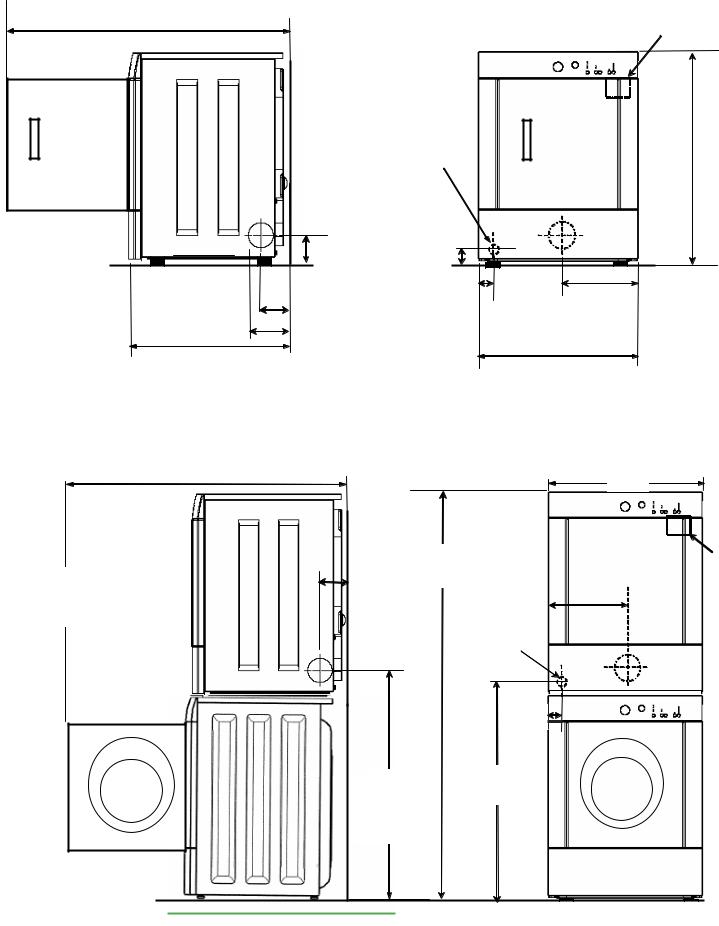
Dryer Installation Dimensions
Free-Standing & Under Counter
48.5” To clear open door |
Electrical supply |
on rear of unit |
|
(123.19cm) |
|
Gas supply pipe on rear of unit
|
|
(5.72cm) |
|
|
|
|
5.0” |
2.25” |
|
|
|
|
(12.7cm) |
|
|
|
|
|
Center line height |
|
|
|
|
|
for rear, right, left |
|
|
(34.29cm) |
|
|
vent |
2.375” |
|
13.5” |
|
|
|
(6.03cm) |
|
||
|
|
To rear & |
|
||
|
4.375” To side exhausts (11.12cm) |
|
|
||
|
|
base exhausts |
|||
(72.39cm) |
5.875” To base exhaust (14.93cm) |
|
|||
|
|
|
|||
28.5” |
27.0” |
|
|||
|
|
|
|||
|
|
|
|
||
27.25 to front of cabinet (69.22cm) |
|
(68.58cm) |
|
||
27.75 to clear knobs (70.49cm) |
|
|
|
|
|
28.5 to clear door handle (72.39cm)
36.0”36"
(91.44cm)
Stacked Dryer Installation Dimensions
28.25” to front of cabinet(71.76cm)
28.75” to clear knobs (73.03cm) 29.5” to clear door handle (74.93cm)
49” to clear open door (124.46cm)
(68.58cm)
27.0”
|
72.00" |
|
|
(11.12cm) |
1.75” |
|
|
|
|||
(182.88cm) |
|
|
|
4.375” |
|
|
|
Side |
|
(34.29cm) |
|
exhausts |
|
13.5” |
|
Gas supply pipe on rear of unit
|
2.375" |
|
2.375” |
|
(6.03cm) |
41.00" |
38.25" |
38” |
|
(10440..75”14cm) |
(97.16cm) |
Center line height for rear, right, left vents
Electrical supply on rear of unit
6

MOBILE HOME INSTALLATION
1.Dryer MUST be exhausted outside (outdoors, not beneath the mobile home) using metal ducting that will not support combustion. Metal ducting must be 4 inches (10.16 cm) in diameter with no obstructions. Rigid metal duct is preferred.
2.If dryer is exhausted through the floor and area beneath the mobile home is enclosed, the exhaust system MUST terminate outside the enclosure with the termination securely fastened to the mobile home structure.
3.When installing a gas dryer into a mobile home, a provision must be made for outside make up air. This provision is to be not less than twice the area of the dryer exhaust outlet.
4.This dryer MUST be fastened to the floor. Mobile Home Installation Kit No. 346764 is available from your dealer.
5.Refer to pages 2 and 3 for other important venting requirements.
6.Installation MUST conform to current Manufactured Home Construction & Safety Standard (which is a Federal Regulation Title 24 CFR-Part 32-80) or when such standard is not applicable, with American National Standard for Mobile Homes.




 The dryer is designed under ANSI Z 21.5.1 or ANSI/ UL2158 - CAN/CSA C22.2 (latest editions) for HOME USE only.
The dryer is designed under ANSI Z 21.5.1 or ANSI/ UL2158 - CAN/CSA C22.2 (latest editions) for HOME USE only.
UNPACKING
1.Using the four shipping carton corner posts (two on each side), carefully lay the dryer on its left side and remove the foam shipping base.
 To prevent damage, do not use the control panel as a means to pick up or move the dryer.
To prevent damage, do not use the control panel as a means to pick up or move the dryer.
2. Return the dryer to an upright position.
PACKING
REVERSING DOOR SWING
Solid Door Reversing Instructions:
1.Open door and remove four (4) plugs in the door opening opposite the hinges. Retain all parts for uses later, unless otherwise noted. Note: Use care in removing plugs in not scratching paint on the front panel.
REMOVE 4 SCREWS (ONE FROM EACH HINGE FIRST)
2.Begin removing the four (4) screws that attach the hinge to the front panel. For best results, start by only removing one screw per hinge. Then only loosen the two remaining screws while firmly holding door to prevent damage to hinge, front panel or door. After the remaining screws are loosened, continue to remove all.
3.Place door handle side down on a towel or pad to prevent any possible scratches to door. Remove all remaining four (4) screws between hinge and door.
4.Remove four (4) screws on opposite side of door.
5.Separate inner door from outer door by placing a flat screw driver or putty knife. Rotate the inner door 180 degree and reassemble the two door halves.
6.Install four (4) screws securing door halves where hinge was previously attached.
7.Install four (4) screws securing hinge to door assembly.
8.Remove striker and discard.
9.Remove square plug and reinstall in hole striker was just removed.
10.Install striker (included in literature bag) into hole square plug was previously installed.
11.Grasping firmly the top of the door, position the door near the door opening and align the top hinge hole to the top hole in the front panel door opening. Once the first screw is started, attach the second screw to the lower hinge. Once both screws are tightened, install the remaining two screws.
12.Install four (4) plugs into the front panel door opening where hinges were originally installed.
7
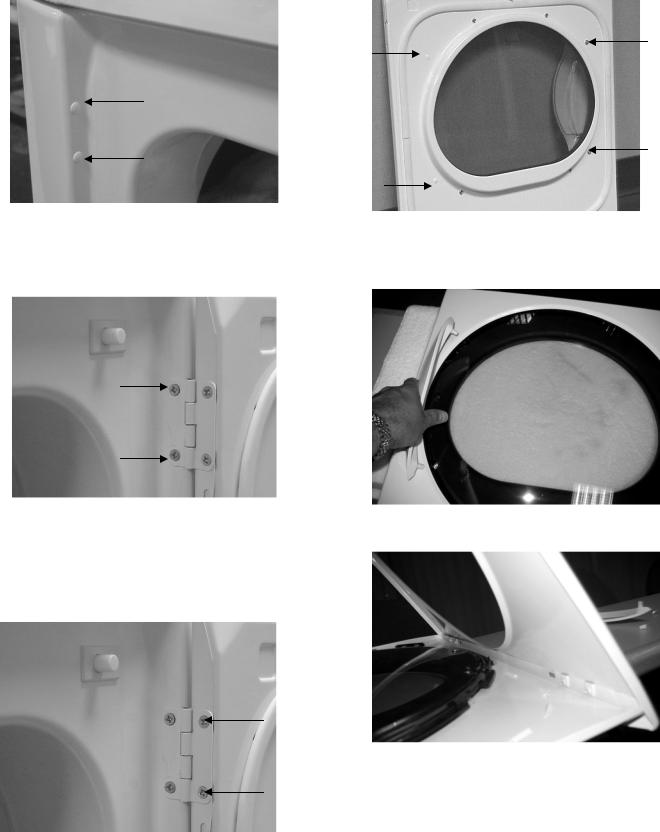
Window Door Reversal Instructions
Figure 1
1.Open door and remove four (4) plugs in the door opening opposite the hinges. Retain all parts for uses later, unless otherwise noted. (Figure 1) Note: Use care in removing plugs in not scratching paint on the front panel.
Figure 2
2. Begin removing the four (4) screws that attach the hinge to the front panel. (Figure 2) For best results, start by only removing one screw per hinge. Then only loosen the two remaining screws while firmly holding door to prevent damage to hinge, front panel or door. After the remaining screws are loosened, continue to remove all.
Figure 3
3.Place door on a towel or pad handle side down to prevent any possible scratches to door. Remove all remaining four (4) screws between hinge and door. (Figure 3)
4.Remove four (4) screws from side of door opposite of where hinge was mounted.
Figure 4
5. Remove two (2) door handle screws and two (2) hole plugs from door. Again taking care not to scratch paint on door. (Figure 4)
Figure 5
6. Pull handle away from door assembley. (Figure 5)
Figure 6
7. Separate the outer door from the inner door assembly with a putty knife or flat screw driver. (Figure 6)
